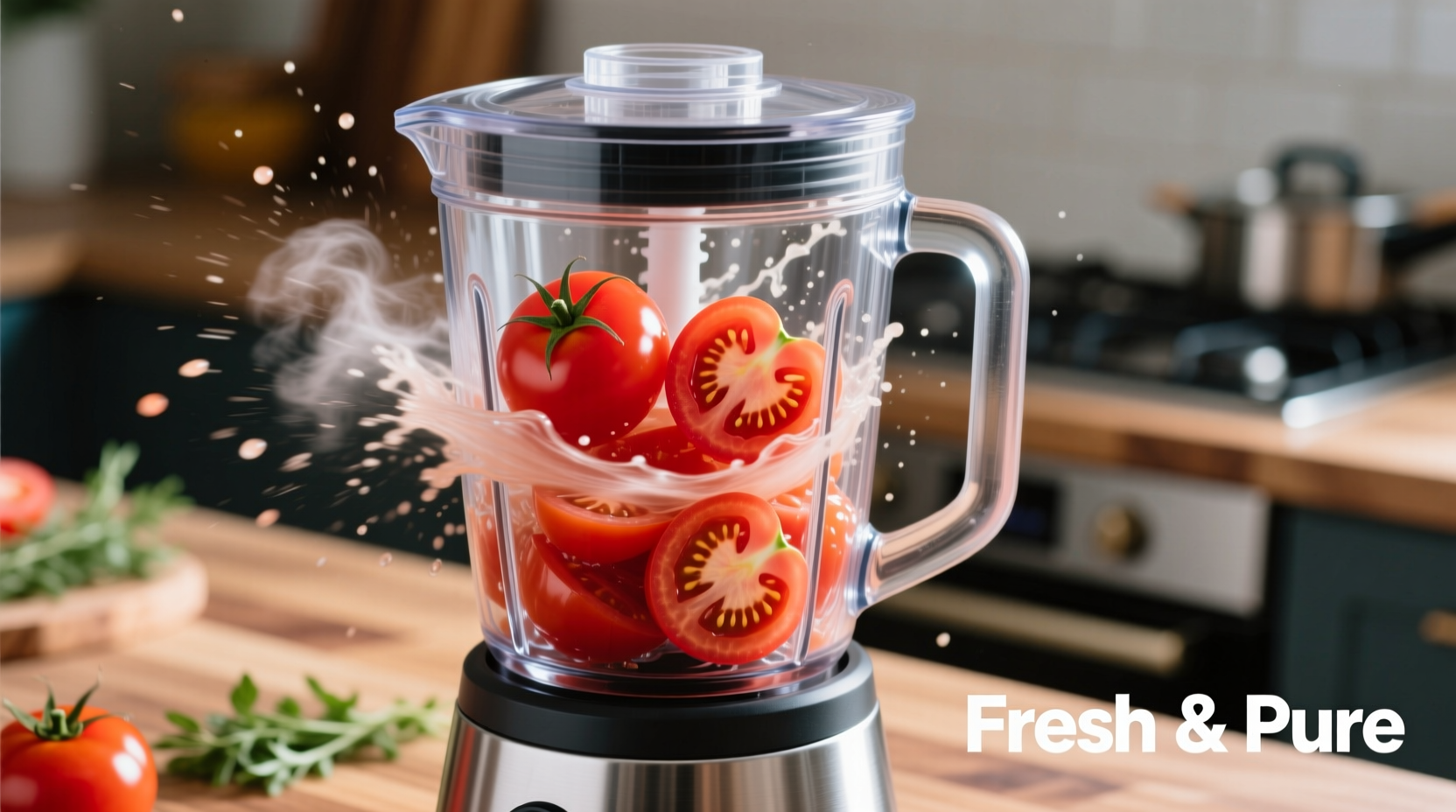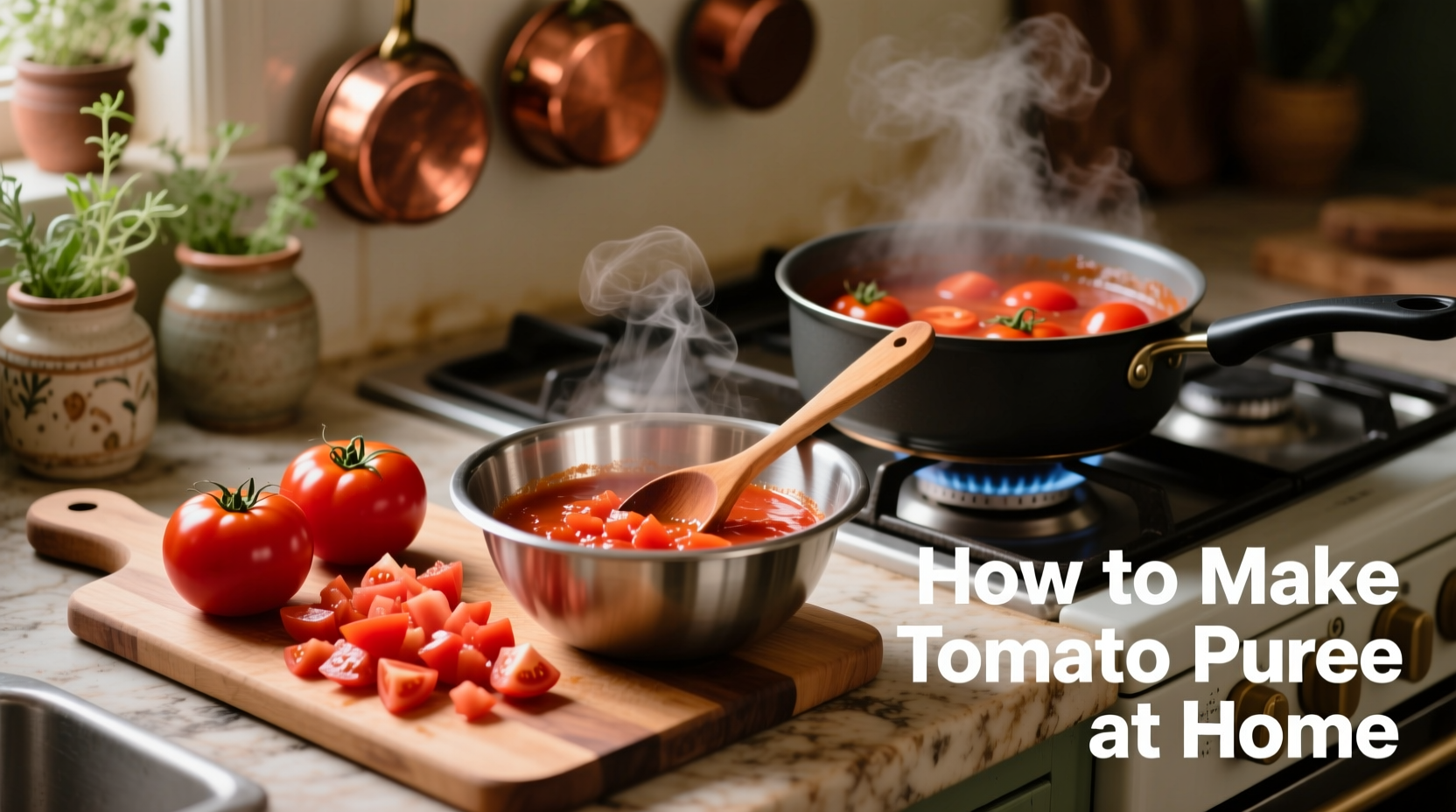Make perfect tomato puree at home in just 30 minutes with 3 simple ingredients: ripe tomatoes, lemon juice, and salt. This foolproof method yields smooth, flavorful puree without additives or preservatives - ideal for sauces, soups, and stews.
Creating vibrant tomato puree at home transforms ordinary dishes into culinary masterpieces. Unlike store-bought versions filled with preservatives, homemade puree delivers unmatched freshness and lets you control texture and flavor intensity. Whether you're crafting a rich marinara, velvety soup, or authentic curry base, this kitchen staple elevates your cooking while saving money.
What You'll Need Before Starting
Gather these essential items before beginning your tomato puree journey. Having everything prepared streamlines the process and prevents mid-recipe scrambling.
| Equipment | Ingredients |
|---|---|
| Large stainless steel pot | 4 pounds ripe tomatoes (Roma preferred) |
| Blender or food mill | 2 tablespoons lemon juice |
| Fine mesh strainer | 1 teaspoon salt |
| Water bath canner (optional) | 1 tablespoon olive oil (optional) |
Step-by-Step Tomato Puree Creation Process
Phase 1: Tomato Preparation (10 minutes)
Start with quality tomatoes - Roma varieties contain less water and more flesh, yielding thicker puree. Wash thoroughly under cold water, removing stems and any blemishes. Score an "X" on the bottom of each tomato with a sharp knife.
Bring a large pot of water to rolling boil while preparing ice bath in large bowl. Blanch tomatoes by submerging in boiling water for 30-60 seconds until skins split, then immediately transfer to ice bath. This thermal shock loosens skins for easy removal.
Phase 2: Cooking and Processing (15 minutes)

Remove skins by gently peeling from the "X" starting point. Chop tomatoes into uniform chunks. Combine tomatoes, lemon juice, and salt in stainless steel pot (avoid aluminum which reacts with acids).
Simmer uncovered over medium heat for 10-15 minutes, stirring occasionally, until tomatoes break down completely. For richer flavor, add olive oil during cooking - this helps extract fat-soluble flavor compounds.
Remove from heat and cool slightly. Transfer to blender in batches, filling only halfway to prevent hot liquid expansion. Blend until completely smooth, about 1 minute per batch. For ultra-smooth texture, strain through fine mesh sieve, pressing with spoon to extract maximum liquid.
Phase 3: Storage Solutions (5 minutes)
Proper storage maintains freshness and prevents spoilage. Cool puree completely before storing. For immediate use (within 5 days), refrigerate in airtight container. For longer preservation:
- Freezing: Pour into ice cube trays, freeze solid, then transfer cubes to labeled freezer bags (keeps 12 months)
- Canning: Process pint jars in water bath canner for 35 minutes (follow USDA guidelines for safe preservation)
When Homemade Tomato Puree Shines (and When It Doesn't)
Understanding context boundaries prevents kitchen disasters. Homemade puree excels in these scenarios:
| Best Applications | Limited Applications |
|---|---|
| Marinara sauces and pizza bases | Commercial canning operations |
| Curry bases and stews | Products requiring 2+ year shelf life |
| Infant food preparation | Large-scale food service without refrigeration |
Commercial producers use specialized equipment for consistent texture and added preservatives for extended shelf life. Home cooks benefit from fresher flavor and ingredient control but should consume within reasonable timeframes.
Troubleshooting Common Issues
Problem: Puree is too watery
Solution: Simmer uncovered longer to evaporate excess liquid. Roma tomatoes naturally yield thicker puree.
Problem: Bitter flavor develops
Solution: Add 1/4 teaspoon baking soda during cooking to neutralize acidity, or include a carrot while simmering to add natural sweetness.
Problem: Separation occurs during storage
Solution: Shake or stir before use. This natural separation indicates no artificial stabilizers - simply remix for perfect consistency.
Tomato Processing Evolution Timeline
Understanding historical context reveals why modern methods work best:
| Era | Processing Method | Key Limitation |
|---|---|---|
| Pre-1900 | Manual crushing through cloth | Inconsistent texture, short shelf life |
| 1920s | Steam-powered mills | Overcooked flavor, nutrient loss |
| 1950s | Centrifugal separation | Added preservatives required |
| Today | Controlled-heat blending | Requires immediate consumption or proper preservation |
Modern home cooks benefit from century-refined techniques that preserve maximum flavor and nutrients while maintaining food safety standards established by the USDA's National Center for Home Food Preservation.
Creative Uses Beyond Basic Sauces
Transform your homemade tomato puree into these culinary delights:
- Tomato water: Strain puree through cheesecloth for delicate consommé base
- Flavor booster: Freeze in ice cube trays then add to soups and stews
- Marinade base: Combine with herbs and olive oil for meats and vegetables
- Infused oils: Simmer puree with garlic and herbs, then strain for flavored oil
Professional chefs often keep tomato puree on hand as a flavor foundation - it adds depth to dishes without overpowering other ingredients. The natural glutamates in tomatoes create umami richness that enhances overall flavor complexity.
Essential Food Safety Guidelines
Follow these critical safety practices when making and storing tomato puree:
- Maintain proper acidity: Add lemon juice (1 tablespoon per pint) to ensure pH below 4.6
- Process canned jars: Use water bath canner for 35 minutes for pints (USDA Complete Guide to Home Canning)
- Refrigerate promptly: Cool puree within 2 hours of cooking
- Check seals: Verify jar lids concave before storing canned products
Improperly preserved tomato products risk botulism contamination. When in doubt about preservation safety, freeze rather than can your puree.
Frequently Asked Questions
Can I make tomato puree without cooking the tomatoes?
Yes, you can create raw tomato puree by blending fresh tomatoes and straining through a fine sieve. However, cooked puree develops richer flavor through caramelization and breaks down cell walls for smoother texture. Raw puree also has shorter shelf life (3 days refrigerated vs 5 days for cooked).
Why does my homemade tomato puree separate in the refrigerator?
Natural separation occurs because homemade puree lacks commercial stabilizers. Simply stir or shake before use. This indicates no artificial additives - a sign of pure, natural product. The liquid contains valuable flavor compounds, so don't discard it.
How do I adjust the thickness of my tomato puree?
For thicker puree, simmer uncovered longer to evaporate excess liquid. For thinner consistency, add reserved tomato liquid or water gradually while blending. The ideal thickness depends on your intended use - pizza sauce requires thicker consistency than soup base.
Can I use green tomatoes for puree?
Yes, but green tomatoes produce more tart puree with different flavor profile. They contain less sugar and more acid, requiring additional sweetener for balanced flavor. Green tomato puree works well in chutneys and certain ethnic dishes but differs from traditional red tomato puree.











 浙公网安备
33010002000092号
浙公网安备
33010002000092号 浙B2-20120091-4
浙B2-20120091-4